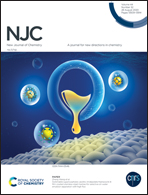Synthesis of organosilocane allied N-heteroaryl Schiff base chemosensor for the detection of Cu2+ metal ions and their biological applications†
Abstract
N-Heteroaryl organosilocanes-based chemosensors have been synthesized for the recognition of copper metal ions with high selectivity. The synthesized compounds (3a–3c) were well characterized by using various spectroscopic techniques such as IR, NMR, TGA, CHN analysis and mass spectroscopy. The detection limit for the chemo-sensing study was determined to be 0.0079 ppm with flourimeteric detection, which is below the WHO guidelines. The shuffling of electron density due to strong binding of the receptor with copper generated a coordination complex which was recognized in the absorption and emission spectrum. The prepared organosilocanes were also used in biological cell lines to estimate the total antioxidant capacity and cytotoxicity activity.



 Please wait while we load your content...
Please wait while we load your content...